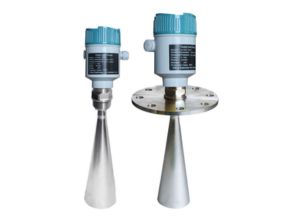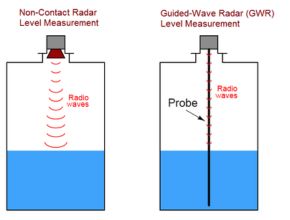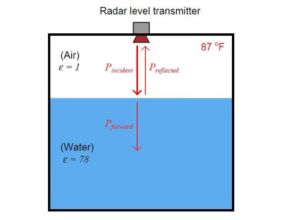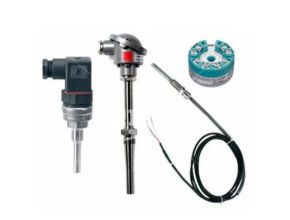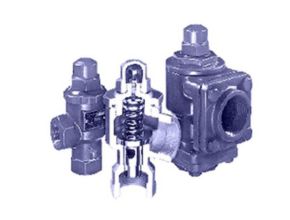The fundamental difference between a radar instrument and an ultrasonic instrument is the type of wave used: radio waves instead of sound waves.
Radar Level Measurement
Radar Level Instruments measure the distance from the transmitter (located at some high point) to the surface of a process material located farther below in much the same way as ultrasonic transmitters – by measuring the time-of-flight of a traveling wave.
Radio waves are electromagnetic in nature (comprised of alternating electric and magnetic fields), and very high frequency (in the microwave frequency range – GHz). Sound waves are mechanical vibrations (transmitted from molecule to molecule in a fluid or solid substance) and of much lower frequency (tens or hundreds of kilohertz – still too high for a human being to detect as a tone) than radio waves. Some radar level instruments use waveguide “probes” to guide the electromagnetic waves to and from the process liquid while others send electromagnetic waves out through open space to reflect off the process material. The instruments using waveguides are called guided-wave radar instruments, whereas the radar instruments relying on open space for signal propagation are called non-contact radar.
Radar Level
The differences between these two varieties of radar instruments is shown in the following illustration:

- The differences between these two varieties of radar instruments is shown in the following illustration:
Photographs of non-contact (left) and guided-wave (right) radar level transmitters are shown below.
The non-contact transmitter is placed on a table for inspection while the guided-wave transmitter is installed in a “cage” similar to that of a displacement-style level transmitter attached to the vessel by two pipes:
Non-contact radar devices suffer much more signal loss than guided-wave radar devices, due to the natural tendency of electromagnetic radiation to disperse over space. Waveguides combat this signal loss by channeling the radio energy along a straight-line path. Probes used in guided-wave radar instruments may be single metal rods, parallel pairs of metal rods, or a coaxial metal rod and- tube structure. Single-rod probes suffer the greatest energy losses, while coaxial probes excel at guiding the microwave energy to the liquid interface and back.
However, single-rod probes are much more tolerant of process fouling than two-rod or (especially) coaxial probes, where sticky masses of viscous liquid and/or solid matter cling to the probe. Such fouling deposits, if severe enough, will cause electromagnetic wave reflections that “look” to the transmitter like the reflection from an actual liquid level or interface.

- Definition and How Radar Level Meter Works
Also, calculate the ullage for this vessel in both units of meters and units of feet/inches, given a reflected pulse (“echo”) time of 11.176 nanoseconds.
Note: the propagation velocity of radio waves in air is approximately 3 × 108 meters per second, the same as the speed of light in a vacuum.
Radar Level working Principle
The basic working principle involves transmitting a burst of electromagnetic waves (microwaves) from the sensor and measuring the time it takes for the waves to travel to the target and back. The time-of-flight is then used to calculate the distance.
Here is the step-by-step process:
- A radar electromagnetic burst is transmitted and directed by a dielectric rod antenna or metal horn antenna.
- The electromagnetic waves (microwaves) propagate toward the surface of the target and then reflect back towards the sensor.
- The reflected waves are received by the same antenna and converted to an electrical signal.
- The electrical signal is amplified and processed.
- The sensor measures the time it takes for the emitted waves to travel to the material surface and back using time-of-flight principle.
- The microprocessor in the sensor calculates the distance to the target using the speed of light, a known variable, and the round-trip time as shown in the following equation:
- Distance = Time x Speed / 2
- Where division by two is required as time measurement is round-trip (to the target and back)
- The calculated distance is converted linearly to 4 mA to 20 mA current. Optionally, information can be sent via RS232 or RS485 to a PC for processing such as diagnostics, programmable set-up and data logging.
- The distance measurement is then used to determine the level of the substance in the tank.
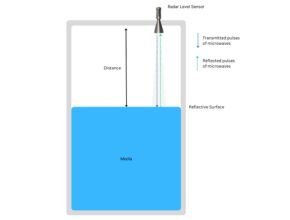
Radar level sensor advantages and disadvantages
Advantage
- Radar level meter is mainly composed of electronic control unit and antenna, no moving parts, no mechanical wear and tear, compared with the mechanical parts of the level measuring instrument has a longer service life. Truly maintenance-free.
- Radar level meter can be used for most of the level measurement of liquid level, the microwave emitted can pass through the vacuum, no need for transmission medium, by the atmosphere, steam, volatile fog in the tank of the influence of small.
- Adopting non-contact measurement, it is not affected by physical characteristics such as density and concentration of liquid level in the tank. Large measuring range, strong corrosion resistance.
- Convenient installation, low failure rate, easy maintenance, high precision, high reliability and other advantages.
- Adopting digital and analog two output modes, it can be configured as single or multiple units according to the bus type, and can be easily connected with the upper monitoring computer.
- Low radiation rate of the instrument, basically no harm to the surrounding environment and personnel.
Disadvantages
- Compared with other liquid level measurement instruments, the price of radar level meter is higher
- Radar level meter can not measure the liquid level of metal, concrete and other materials made of containers
- The measurement range of radar level meter is limited by antenna size and process conditions.
Conclusion
Radar and ultrasonic instruments both measure the distance to a target surface, but they use different types of waves: radar uses radio waves, while ultrasonic instruments use sound waves. Radar level instruments can be classified into guided-wave radar and non-contact radar. Guided-wave radar uses probes to direct the electromagnetic waves, reducing signal loss and improving accuracy. Non-contact radar, however, experiences more signal loss due to the dispersion of electromagnetic radiation in open space. Despite these differences, both types of radar instruments provide reliable and maintenance-free level measurement, unaffected by the physical properties of the medium. They are suitable for a wide range of applications, although they tend to be more expensive and have limitations in measuring levels in metal or concrete containers.
FAQ
Q1: What is the fundamental difference between radar and ultrasonic level instruments? A1: The fundamental difference is the type of wave used: radar instruments use radio waves (electromagnetic waves) while ultrasonic instruments use sound waves (mechanical vibrations).
Q2: How do radar level instruments measure distance? A2: Radar level instruments measure distance by transmitting a burst of electromagnetic waves, which travel to the surface of the target material and reflect back to the sensor. The time it takes for the waves to make this round trip is used to calculate the distance.
Q3: What are the two types of radar level instruments, and how do they differ? A3: The two types are guided-wave radar and non-contact radar. Guided-wave radar uses probes to guide the electromagnetic waves, minimizing signal loss. Non-contact radar sends waves through open space, which can result in greater signal loss due to dispersion.
Q4: What are the advantages of using radar level meters? A4: Advantages include:
- No moving parts, leading to longer service life and low maintenance.
- Unaffected by the physical properties of the liquid, such as density and concentration.
- Capable of non-contact measurement.
- High precision and reliability.
- Digital and analog output options.
- Low radiation, making them safe for the environment and personnel.
Q5: Are there any disadvantages to radar level meters? A5: Disadvantages include:
- Higher cost compared to other level measurement instruments.
- Inability to measure levels in metal or concrete containers.
- Measurement range limitations based on antenna size and process conditions.
Q6: How is the ullage of a vessel calculated using radar level meters? A6: Ullage can be calculated by determining the time-of-flight of the radar waves. Given a reflected pulse time of 11.176 nanoseconds and a propagation velocity of 3×1083 \times 10^8 meters per second, the distance is calculated using the formula:
Distance=Time×Speed2\text{Distance} = \frac{\text{Time} \times \text{Speed}}{2}
Converting this distance into meters or feet/inches provides the ullage measurement.
For further reading, you can explore additional details on radar level measurement on technical resources or manufacturer websites.
Refference :

